Stacy Liberatore For Dailymail.com -
A pair of grass covered mounds located on a Louisiana college campus have been deemed the oldest-known structures in North America after carbon data revealed construction on Mound B started 11,000 years ago and Mound A around 7,500 years ago - making them about 6,000 years older than the ancient Egyptian pyramids.
Constructed by indigenous people on what is now Louisiana State University (LSU) in Baton Rouge, the mounds stand about 20 feet tall and are believed to have been used for ceremonial purposes because they align with one of the brightest stars in the night sky - a red giant known as Arcturus.
The theory stems from discoveries of ash from burned reed and cane plants, as well as the burned bone fragments, found beneath the grass and dirt.
These mounds are among 800 man-made, hill-like mounds in the state that were built by indigenous people, however, many of the others have been destroyed.
Mound B, the oldest of the pair, is believed to have been built over a few thousands of years - layer by layer.
The mound was eventually abandoned around 8,200 years ago, which was determined by aging roots found in the sediment layer.

The pair of mounds sit on the Louisiana State University of campus and are among 800 man-made structures of its kind in North America
LSU Department of Geology & Geophysics Professor Emeritus Brooks Ellwood, who led this study, said in a statement: 'We don't know why they abandoned the mounds around 8,200 years ago, but we do know their environment changed suddenly and dramatically, which may have affected many aspects of their daily life.'
Then, around 7,500 years ago, the indigenous people began to build a new mound just to the north of the first mound.
Mound A contains mud that is saturated with water, which liquefies when agitated.
As a result, Mound A is unstable and degrading, and the public is urged to stay clear of it.

© Provided by Daily MailMound B started 11,000 years ago and Mound A around 7,500 years ago - making them about 6,000 years older than the ancient Egyptian pyramids

A pair of grass covered mounds located on a Louisiana college campus have been deemed the oldest-known structures in North America after carbon data revealed construction on Mound B started 11,000 years ago and Mound A around 7,500 years ago - making them about 6,000 years older than the ancient Egyptian pyramids.
Constructed by indigenous people on what is now Louisiana State University (LSU) in Baton Rouge, the mounds stand about 20 feet tall and are believed to have been used for ceremonial purposes because they align with one of the brightest stars in the night sky - a red giant known as Arcturus.
The theory stems from discoveries of ash from burned reed and cane plants, as well as the burned bone fragments, found beneath the grass and dirt.
These mounds are among 800 man-made, hill-like mounds in the state that were built by indigenous people, however, many of the others have been destroyed.
Mound B, the oldest of the pair, is believed to have been built over a few thousands of years - layer by layer.
The mound was eventually abandoned around 8,200 years ago, which was determined by aging roots found in the sediment layer.

The pair of mounds sit on the Louisiana State University of campus and are among 800 man-made structures of its kind in North America
LSU Department of Geology & Geophysics Professor Emeritus Brooks Ellwood, who led this study, said in a statement: 'We don't know why they abandoned the mounds around 8,200 years ago, but we do know their environment changed suddenly and dramatically, which may have affected many aspects of their daily life.'
Then, around 7,500 years ago, the indigenous people began to build a new mound just to the north of the first mound.
Mound A contains mud that is saturated with water, which liquefies when agitated.
As a result, Mound A is unstable and degrading, and the public is urged to stay clear of it.

© Provided by Daily MailMound B started 11,000 years ago and Mound A around 7,500 years ago - making them about 6,000 years older than the ancient Egyptian pyramids

They were likely used in ceremonial events because they align with one of the brightest stars in the night sky - a red giant known as Arcturus. The theory stems from discoveries of ash from burned reed and cane plants, as well as the burned bone fragments, found beneath the grass and dirt
The star the pair align with is believed to be the red giant Arcturus that rose about 8.5 degrees east of north in the night sky, which means it would have aligned along the crests of both LSU Campus Mounds.
Arcturus is also one of the brightest stars that can be seen from Earth.
'The people who constructed the mounds, at about 6,000 years ago, coordinated the structures' orientation to align with Arcturus, seen in the night sky at that time,' Ellwood said.
'The oldest previously dated and well-documented published dates for mounds built by Indigenous People in North America are from the Monte Sano mounds discussed above, with ages from 7,575-4,956 calBP [BC], and also a ca. 5,500 BP date from the Watson Brake mound complex in NE Louisiana (Saunders and others, 1997), a site at which the Indigenous mounds have not been destroyed,' reads the study published in American Journal of Science.
Earlier this month the oldest settlement in North America was discovered in new Mexico.

lEarlier this month the oldest settlement in North America was discovered in new Mexico. Bones of an adult mammoth and her calf have been uncovered at a 37,000-year-old butchering site
Bones of an adult mammoth and her calf have been uncovered at a 37,000-year-old butchering site, which suggest humans settled in North America 17,000 years than previously believed.
A team of scientists, led by The University of Texas at Austin, extracted collagen from the bones, allowing them to carbon date the settled age of 36,250 to 38,900 years old.
The bones were discovered in a three-foot-tall pile, with 95 percent belonging to the adult, and featured slaughter marks and fractures from blunt force impact.
Both of these discoveries, the ages of the mounds and settlement, add to the growing evidence that there were societies before people crossed the Bering Strait land bridge some 20,000 years ago. The bridge, also called Beringia, connected Siberia and during the last Ice Age, and allowed people to come from into North America.
The star the pair align with is believed to be the red giant Arcturus that rose about 8.5 degrees east of north in the night sky, which means it would have aligned along the crests of both LSU Campus Mounds.
Arcturus is also one of the brightest stars that can be seen from Earth.
'The people who constructed the mounds, at about 6,000 years ago, coordinated the structures' orientation to align with Arcturus, seen in the night sky at that time,' Ellwood said.
'The oldest previously dated and well-documented published dates for mounds built by Indigenous People in North America are from the Monte Sano mounds discussed above, with ages from 7,575-4,956 calBP [BC], and also a ca. 5,500 BP date from the Watson Brake mound complex in NE Louisiana (Saunders and others, 1997), a site at which the Indigenous mounds have not been destroyed,' reads the study published in American Journal of Science.
Earlier this month the oldest settlement in North America was discovered in new Mexico.

lEarlier this month the oldest settlement in North America was discovered in new Mexico. Bones of an adult mammoth and her calf have been uncovered at a 37,000-year-old butchering site
Bones of an adult mammoth and her calf have been uncovered at a 37,000-year-old butchering site, which suggest humans settled in North America 17,000 years than previously believed.
A team of scientists, led by The University of Texas at Austin, extracted collagen from the bones, allowing them to carbon date the settled age of 36,250 to 38,900 years old.
The bones were discovered in a three-foot-tall pile, with 95 percent belonging to the adult, and featured slaughter marks and fractures from blunt force impact.
Both of these discoveries, the ages of the mounds and settlement, add to the growing evidence that there were societies before people crossed the Bering Strait land bridge some 20,000 years ago. The bridge, also called Beringia, connected Siberia and during the last Ice Age, and allowed people to come from into North America.















